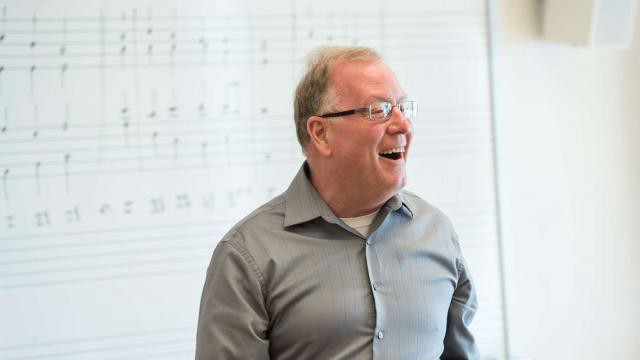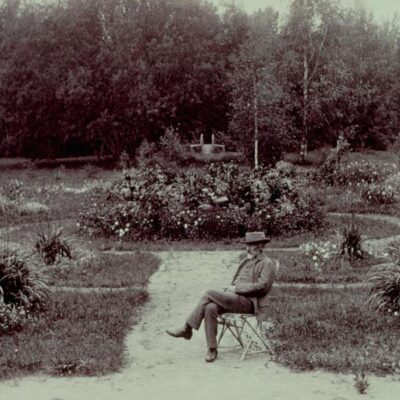California Symphony goers know her as the sharply dressed orchestra executive who addresses the audience before every concert. To peers in the field, she is a thought leader and sought-after speaker, with a reputation for challenging traditional thinking and established practices in orchestra management. Since becoming Executive Director in 2014, the California Symphony has been Aubrey’s proving ground to try new patron loyalty and marketing strategies—and with audiences growing, performances added to satisfy demand, and a growing family of donors at all levels of support, we think she may be onto something.

We talked with Aubrey about her experience in arts management, her pathway to the California Symphony, and why she believes so passionately in changing the narrative for symphony orchestras.
California Symphony Orchestra: We hear you decided you wanted to be an Executive Director when you were in high school, which is pretty unusual since most people don’t even know this is a profession until much later in life. Tell us more.
Aubrey Bergauer: I was 16 years old. I grew up in Houston playing tuba in the youth orchestra there, after winning an audition for it in eighth grade. Two years later when I was a sophomore in high school, the orchestra went through an executive director change. I remember at the start of rehearsal one day, the new ED was introduced, and they said maybe one sentence about what that role was.
For me that was the lightbulb moment: “There is a job managing this entire operation,” I realized, “and that’s the job I want.”
CSO: Having identified that goal, how did you plot your career to achieve that end?
AB: My background has always been in the arts — from playing an instrument very seriously growing up, to graduating with degrees in music performance and business from Rice University, to my first job out of college at Seattle Symphony. I started there in the development (fundraising) department planning all the donor stewardship activities for individuals of all giving levels, foundations and corporations, and planned giving/bequest donors.
Then one day, Seattle Opera called and wanted me to bring my event planning experience to oversee their young patrons club for attendees in their 20s and 30s, called the BRAVO! Club (originally modeled after San Francisco Opera’s club of the same name). Around that time, digital marketing and social media were emerging marketing tactics, and I became fascinated with them. I so clearly remember being the kid in the office pushing for us to be one of the first major arts organizations to set up a Facebook page and Twitter account, and diving into the data that came from digital advertising — and using that information to inform what worked. Suddenly, things that used to be subjective choices (What color should this ad be? Should the ad have this headline or that one?) became testable, measurable, and completely data-driven objective decisions. That rocked my world and completely changed how I viewed marketing because it took a lot of the guesswork out of it.
After nearly six years at Seattle Opera, my role had expanded to lots of different single ticket initiatives, audience development work, the digital and social media growth and tracking, several technology projects (website content, videos, live streaming, mobile development, among others) funded by a major grant award from the Wallace Foundation, and filling in on managing part of the subscription campaign (a big portion of the company’s $10 Million earned revenue goal) while two senior colleagues were on leave at the same time.
In early 2012, the Bumbershoot Music & Arts Festival — the nation’s largest urban arts festival which draws 120,000+ people to Seattle Center (think where the Space Needle is) each year — brought me on as their marketing director. At the time, I was so nervous to step outside of classical music, and quickly came to love it because of how it opened my eyes to a broader world view, from the genres of music to the types of marketing tactics I was employing, to the organizational culture. During my time there, revenue grew by 43% — a stat I thought I’d never see again in my career because that’s some serious growth — and little did I know that in 2014 a small symphony orchestra in Walnut Creek, California was ripe for that kind of growth and more.
That year, the California Symphony brought me on as Executive Director, my first time at the helm of an organization, and now I’m in my fifth season here. This was the place I decided to come to put together everything I had learned from my previous jobs, where I had developed a lot of ideas and opinions on strategies for marketing, fundraising, programming, and how to grow and retain a loyal audience. At the time, the orchestra was on the verge of collapse, but I saw the fundamentals were there: a fantastic artistic product, an amazing social justice El Sistema-based education program, and a composer-in-residence program that was nationally known for launching the careers of several of today’s most prominent living composers. “This is a mission I can get behind,” I remember thinking, “one I can raise money for and build a following for.”
Four years later, we have nearly doubled the audience and nearly quadrupled the donor base. Almost every season has ended with a surplus, so we’ve nearly eliminated the past debt the organization had accumulated, and now we’re growing the endowment in addition to continuing expanding our programs and number of people served. I am so proud of all we have achieved here — what a ride it has been!
CSO: You often talk about how we like to do things a little different at the California Symphony. What does that mean to you in practice?
AB: It means a lot of things! Sometimes this means a fairly significant departure from the traditional schools of thought for orchestra management, such as how we are dogmatic about not soliciting someone for a donation [via direct mail and telephone] until they are a second-year season ticket holder. (The standard approach for most arts organizations is to start soliciting for donations and subscriptions after someone’s first visit.)
Usually though, “doing things a little different” means we’ve made many small changes — from trying to eliminate technical musical language or jargon in our materials, to swapping long, effusive marketing copy for bullet points on “what’s interesting about this concert,” to printing in the program book that people can clap when they like what they hear and keep their phones on (and silent) — and all of that adds up to a full approach to serving our patrons differently.
Industry colleagues ask me all the time if we’ve alienated our core concertgoers, i.e. loyal, longtime patrons, by doing these things, and the answer is that the response has been emphatically positive because everyone sees that the concert hall used to be half full and now it’s packed. Everyone, whether that’s new attendees or longtime attendees or the musicians on stage, feels the energy from a full house, and it’s just so much more FUN that way. And our season ticket renewal rates support that sentiment.

CSO: You’ve been writing a blog since 2016. What do you write about and why?
AB: I write about all the things in the answer above, meaning I write about the need to put our customers first, the deep need for a focus on patron retention/loyalty in this industry, and how the music itself is not the source of any of those problems.
Yes, I believe that really traditional orchestral programming of all the same old music needs a refresh (and I write about that too), but it doesn’t matter how much we tinker with the product when there are many elements of the concert experience that are unwelcoming, intimidating, or just confusing to a lot of people who don’t have a lot of prior knowledge of the art form (which, because of the declines in music education, is a lot of the population). So I write to help us all collectively as arts administrators put some intention behind what is often unintentionally happening at our organizations.
Lastly, when I started this blog and still true a few years later is that I write to not just talk about the challenges our organizations face, but rather, what we’ve actually done to try to address them. And the hope is that others reading find it helpful in their work too.
“I keep your blog posts printed out on my desk, as a mini-bible of creativity / fantastic outside-of-the-box thinking.”—An Arts Manager fan of Aubrey’s blog
CSO: What is your vision for the future of the California Symphony?
AB: I love that the name of this orchestra is so big. A name like that means we can vision and grow to be almost anything: we can serve more people, expand our geographic presence, and continue to be a leader for our peers across the nation.
CSO: What is the proudest achievement in your career to date?
AB: On a project level, it’s the Orchestra X project hands down, because of the way it so radically changed my own views of the patron experience.
On a larger scale, the turnaround of the California Symphony will always be one my proudest achievements. Five years ago, it almost closed the doors, had massive debt relative to the size of operating budget, and almost no cash to continue. Bringing this organization back from the brink and using all the research, retention efforts, and patron focus I’ve mentioned above to do that has forever changed my approach to orchestra management. I talk a lot about changing the narrative for symphony orchestras, and this organization is proof that it absolutely can be done.
You can find Aubrey’s blog at https://medium.com/@AubreyBergauer


